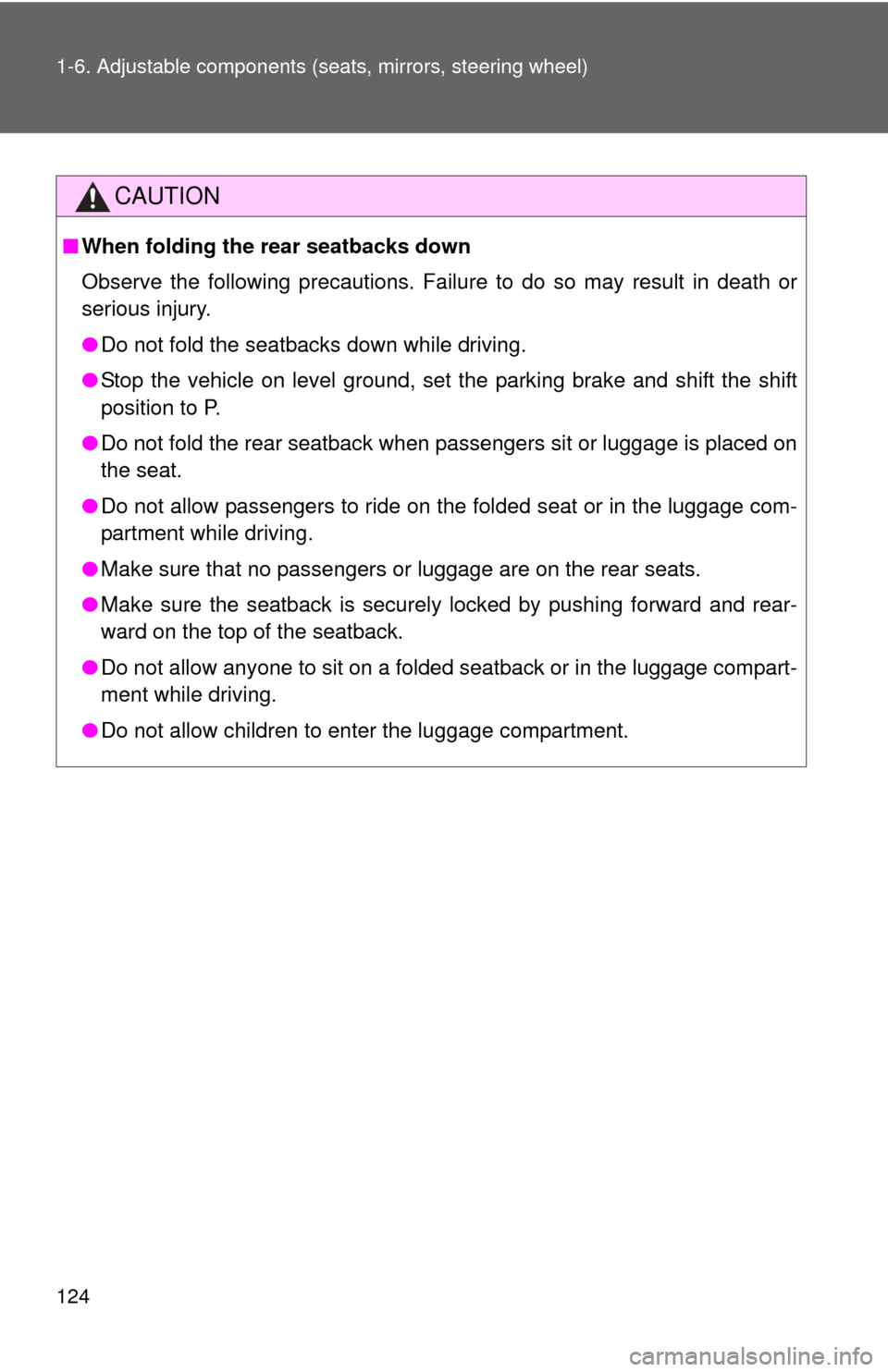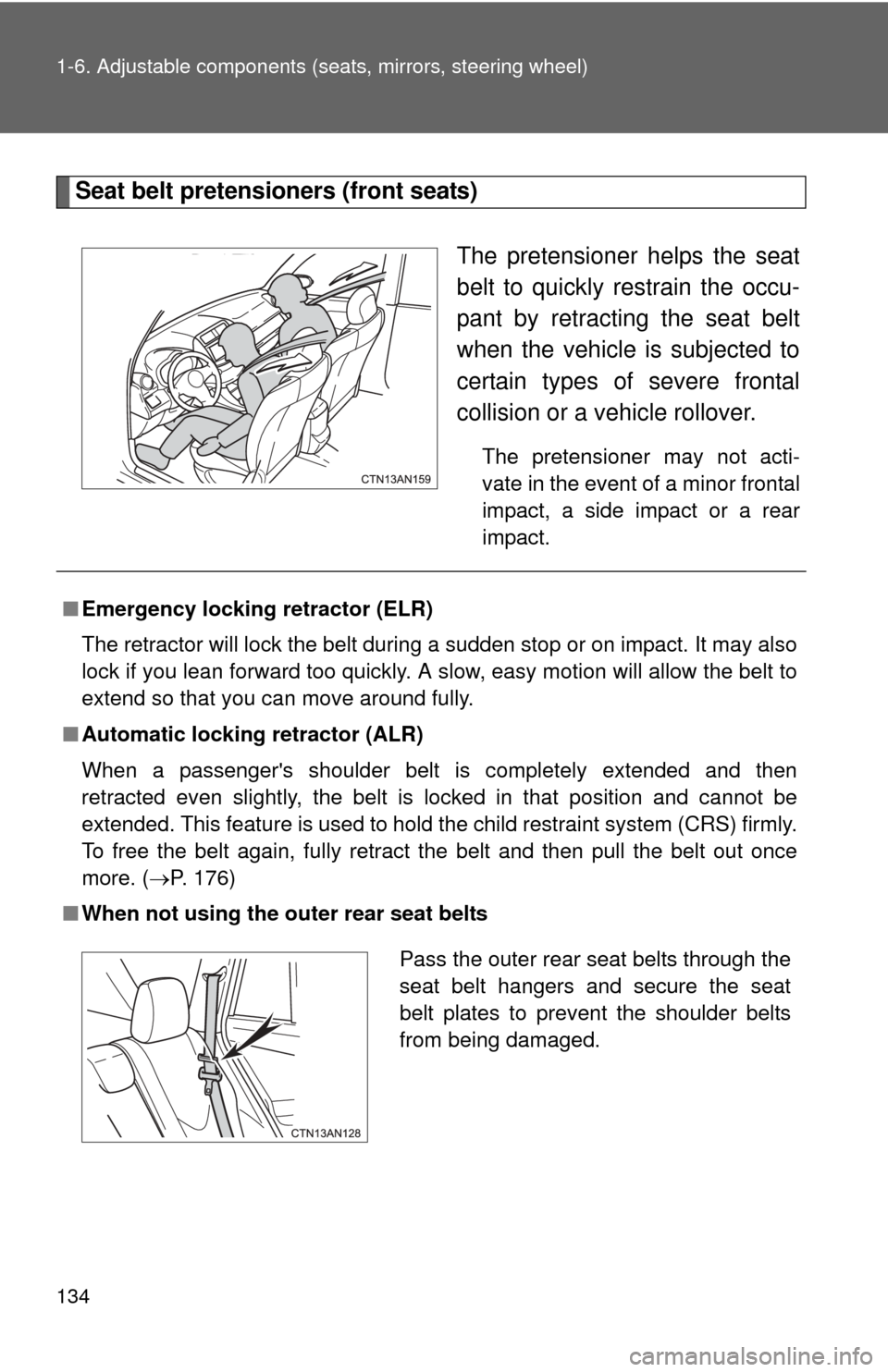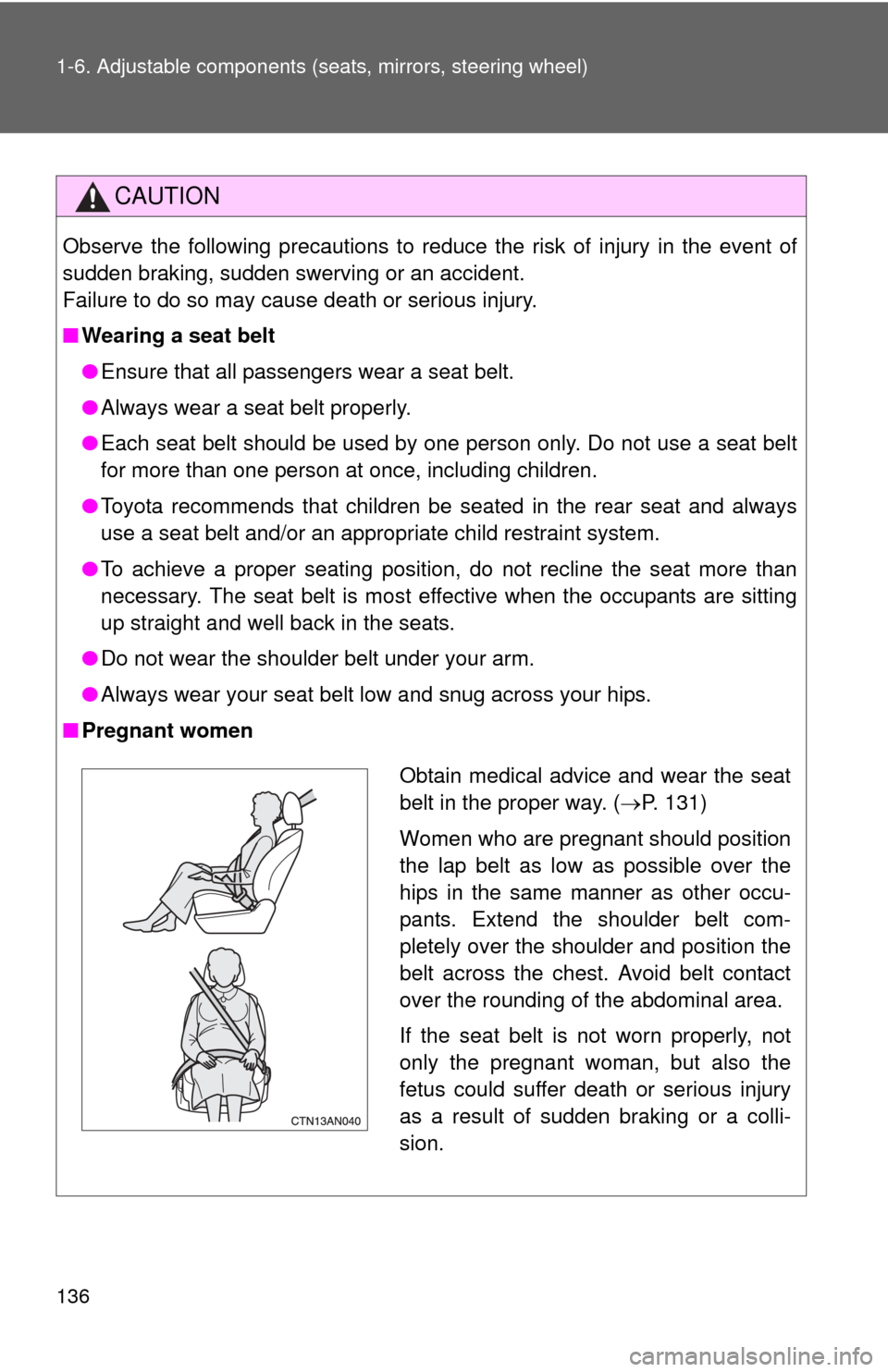2013 TOYOTA RAV4 EV child seat
[x] Cancel search: child seatPage 2 of 520

TABLE OF CONTENTSIndex
2
1-1. EV systemCharacteristics of the EV (Electric Vehicle) system .... 26
EV (Electric Vehicle) system precautions ............ 32
Energy monitor/ consumption screen ........... 38
EV (Electric Vehicle) driving tips .......................... 41
1-2. Navigation system screen operations
Navigation system screen operations .......................... 44
1-3. Charging Charging equipment ............. 46
Power sources that can be used .............................. 50
Charging and pre-climate (Remote Climate Control)
procedures ......................... 53
When normal charging cannot be carried out ......... 88
Inspecting the charging cable .................................. 92
1-4. Key information Keys ..................................... 94 1-5. Opening, closing and
locking the doors
Smart key system ................. 96
Wireless remote control ...... 108
Side doors .......................... 110
Back door ........................... 113
1-6. Adjustable components (seats, mirrors,
steering wheel)
Front seats.......................... 118
Rear seats .......................... 121
Head restraints ................... 127
Seat belts............................ 131
Steering wheel .................... 140
Anti-glare inside rear view mirror ........................ 141
Outside rear view mirrors ... 143
1-7. Opening and closing the windows
Power windows................... 146
1-8. Theft deterrent system Immobilizer system ............. 149
Theft prevention labels ....... 151
1-9. Safety information Correct driving posture ....... 152
SRS airbags ....................... 154
Front passenger occupant classification system ......... 166
Child restraint systems ....... 172
Installing child restraints ..... 176
1Before driving
Page 25 of 520

Before driving1
25
1-1. EV systemCharacteristics of the EV (Electric Vehicle)
system ............................. 26
EV (Electric Vehicle) system precautions .......... 32
Energy monitor/ consumption screen......... 38
EV (Electric Vehicle) driving tips........................ 41
1-2. Navigation system screen operations
Navigation system screen operations ........................ 44
1-3. Charging Charging equipment........... 46
Power sources that can be used ............................ 50
Charging and pre-climate (Remote Climate Control)
procedures ....................... 53
When normal charging cannot be carried out ....... 88
Inspecting the charging cable ................................ 92
1-4. Key information Keys ................................... 94
1-5. Opening, closing and locking the doors
Smart key system .............. 96 Wireless remote control ... 108
Side doors ........................ 110
Back door ......................... 113
1-6. Adjustable components (seats, mirrors,
steering wheel)
Front seats ....................... 118
Rear seats........................ 121
Head restraints................. 127
Seat belts ......................... 131
Steering wheel ................. 140
Anti-glare inside rear view mirror ..................... 141
Outside rear view mirrors ............................ 143
1-7. Opening and closing the windows
Power windows ................ 146
1-8. Theft deterrent system Immobilizer system .......... 149
Theft prevention labels..... 151
1-9. Safety information Correct driving posture..... 152
SRS airbags ..................... 154
Front passenger occupant classification system ...... 166
Child restraint systems..... 172
Installing child restraints ........................ 176
Page 112 of 520

112 1-5. Opening, closing and locking the doors
■Using the mechanical key
The doors can also be locked and unlocked with the mechanical key.
(P. 468)
■ When all the doors are locked with the entry function, wireless remote
control or key
The doors cannot be unlocked with the door lock switch.
The door lock switch can be reset by unlocking all the doors with the entry
function, wireless remote control or key.
■ The doors cannot be locked when
The “POWER” switch is in ACCESSORY or ON mode, or the electronic key
is left inside the vehicle.
Depending on the position of the electronic key, the key may not be detected
correctly and the door may be locked.
■ Customization that can be co nfigured at Toyota dealer
Settings (e.g. door unlocking function) can be changed.
(Customizable features P. 500)
CAUTION
■To prevent an accident
Observe the following precautions while driving the vehicle.
Failure to do so may result in a door opening and an occupant falling out,
resulting in death or serious injury.
●Always use a seat belt.
● Always lock all the doors.
● Ensure that all doors are properly closed.
● Do not pull the inside handle of the doors while driving.
The doors may be opened and the passengers are thrown out of the vehi-
cle and it may result in serious injury or death.
Be especially careful for the front doors, as the doors may be opened even
if the inside lock buttons are in locked position.
● Set the rear door child-protector locks when children are seated in the rear
seats.
Page 124 of 520

124 1-6. Adjustable components (seats, mirrors, steering wheel)
CAUTION
■When folding the rear seatbacks down
Observe the following precautions. Failure to do so may result in death or
serious injury.
●Do not fold the seatbacks down while driving.
● Stop the vehicle on level ground, set the parking brake and shift the shift
position to P.
● Do not fold the rear seatback when passengers sit or luggage is placed on
the seat.
● Do not allow passengers to ride on the folded seat or in the luggage com-
partment while driving.
● Make sure that no passengers or luggage are on the rear seats.
● Make sure the seatback is securely locked by pushing forward and rear-
ward on the top of the seatback.
● Do not allow anyone to sit on a folded seatback or in the luggage compart-
ment while driving.
● Do not allow children to enter the luggage compartment.
Page 134 of 520

134 1-6. Adjustable components (seats, mirrors, steering wheel)
Seat belt pretensioners (front seats)
The pretensioner helps the seat
belt to quickly restrain the occu-
pant by retracting the seat belt
when the vehicle is subjected to
certain types of severe frontal
collision or a vehicle rollover.
The pretensioner may not acti-
vate in the event of a minor frontal
impact, a side impact or a rear
impact.
■Emergency locking retractor (ELR)
The retractor will lock the belt during a sudden stop or on impact. It may also
lock if you lean forward too quickly. A slow, easy motion will allow the belt to
extend so that you can move around fully.
■ Automatic locking retractor (ALR)
When a passenger's shoulder belt is completely extended and then
retracted even slightly, the belt is locked in that position and cannot be
extended. This feature is used to hold the child restraint system (CRS) firmly.
To free the belt again, fully retract the belt and then pull the belt out once
more. ( P. 176)
■ When not using the ou ter rear seat belts
Pass the outer rear seat belts through the
seat belt hangers and secure the seat
belt plates to prevent the shoulder belts
from being damaged.
Page 135 of 520

135
1-6. Adjustable components (s
eats, mirrors, steering wheel)
1
Before driving
■Child seat belt usage
The seat belts of your vehicle were principally designed for persons of adult
size.
●Use a child restraint system appropriate for the child, until the child
becomes large enough to properly wear the vehicle's seat belt. ( P. 172)
● When the child becomes large enough to properly wear the vehicle's seat
belt, follow the instructions on P. 131 regarding seat belt usage.
■ Replacing the belt after the pretensioner has been activated
If the vehicle is involved in multiple collisions, the pretensioner will activate
for the first collision, but will not activate for the second or subsequent colli-
sions.
■ Seat belt extender
If your seat belts cannot be fastened
securely because they are not long
enough, a personalized seat belt
extender is available from your Toyota
dealer free of charge.
Page 136 of 520

136 1-6. Adjustable components (seats, mirrors, steering wheel)
CAUTION
Observe the following precautions to reduce the risk of injury in the event of
sudden braking, sudden swerving or an accident.
Failure to do so may cause death or serious injury.
■Wearing a seat belt
●Ensure that all passengers wear a seat belt.
● Always wear a seat belt properly.
● Each seat belt should be used by one person only. Do not use a seat belt
for more than one person at once, including children.
● Toyota recommends that children be seated in the rear seat and always
use a seat belt and/or an appropriate child restraint system.
● To achieve a proper seating position, do not recline the seat more than
necessary. The seat belt is most effective when the occupants are sitting
up straight and well back in the seats.
● Do not wear the shoulder belt under your arm.
● Always wear your seat belt low and snug across your hips.
■ Pregnant women
Obtain medical advice and wear the seat
belt in the proper way. ( P. 131)
Women who are pregnant should position
the lap belt as low as possible over the
hips in the same manner as other occu-
pants. Extend the shoulder belt com-
pletely over the shoulder and position the
belt across the chest. Avoid belt contact
over the rounding of the abdominal area.
If the seat belt is not worn properly, not
only the pregnant woman, but also the
fetus could suffer death or serious injury
as a result of sudden braking or a colli-
sion.
Page 137 of 520

137
1-6. Adjustable components (s
eats, mirrors, steering wheel)
1
Before driving
CAUTION
■People suffering illness
Obtain medical advice and wear the seat belt in the proper way. ( P. 131)
■ When children are in the vehicle
Do not allow children to play with the seat belt. If the seat belt becomes
twisted around a child’s neck, it may lead to choking or other serious injuries
that could result in death.
If this occurs and the buckle cannot be unfastened, scissors should be used
to cut the belt.
■ Seat belt pretensioners
●Do not place anything, such as a cushion, on the front passenger's seat.
Doing so will disperse the passenger's weight, which prevents the sensor
from detecting the passenger's weight properly. As a result, the seat belt
pretensioner for the front passenger's seat may not activate in the event of
a collision.
● If the pretensioner has activated, the SRS warning light will come on. In
that case, the seat belt cannot be used again and must be replaced at
your Toyota dealer.
■ Adjustable shoulder anchor
Always make sure the shoulder belt is positioned across the center of your
shoulder. The belt should be kept away from your neck, but not falling off
your shoulder. Failure to do so could reduce the amount of protection in an
accident and cause death or serious injuries in the event of a sudden stop,
sudden swerve or accident. ( P. 132)